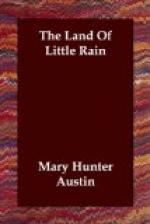Once in a year or so we have a “big snow.” The cloud tents are widened out to shut in the valley and an outlying range or two and are drawn tight against the sun. Such a storm begins warm, with a dry white mist that fills and fills between the ridges, and the air is thick with formless groaning. Now for days you get no hint of the neighboring ranges until the snows begin to lighten and some shouldering peak lifts through a rent. Mornings after the heavy snows are steely blue, two-edged with cold, divinely fresh and still, and these are times to go up to the pine borders. There you may find floundering in the unstable drifts “tainted wethers” of the wild sheep, faint from age and hunger; easy prey. Even the deer make slow going in the thick fresh snow, and once we found a wolverine going blind and feebly in the white glare.
No tree takes the snow stress with such ease as the silver fir. The star-whorled, fan-spread branches droop under the soft wreaths—droop and press flatly to the trunk; presently the point of overloading is reached, there is a soft sough and muffled dropping, the boughs recover, and the weighting goes on until the drifts have reached the midmost whorls and covered up the branches. When the snows are particularly wet and heavy they spread over the young firs in green-ribbed tents wherein harbor winter loving birds.
All storms of desert hills, except wind storms, are impotent. East and east of the Sierras they rise in nearly parallel ranges, desertward, and no rain breaks over them, except from some far-strayed cloud or roving wind from the California Gulf, and these only in winter. In summer the sky travails with thunderings and the flare of sheet lightnings to win a few blistering big drops, and once in a lifetime the chance of a torrent. But you have not known what force resides in the mindless things until you have known a desert wind. One expects it at the turn of the two seasons, wet and dry, with electrified tense nerves. Along the edge of the mesa where it drops off to the valley, dust devils begin to rise white and steady, fanning out at the top like the genii out of the Fisherman’s bottle. One supposes the Indians might have learned the use of smoke signals from these dust pillars as they learn most things direct from the tutelage of the earth. The air begins to move fluently, blowing hot and cold between the ranges. Far south rises a murk of sand against the sky; it grows, the wind shakes itself, and has a smell of earth. The cloud of small dust takes on the color of gold and shuts out the neighborhood, the push of the wind is unsparing. Only man of all folk is foolish enough to stir abroad in it. But being in a house is really much worse; no relief from the dust, and a great fear of the creaking timbers. There is no looking ahead in such a wind, and the bite of the small sharp sand on exposed skin is keener than any insect sting. One might sleep, for the lapping of the wind wears one to the point of exhaustion very




